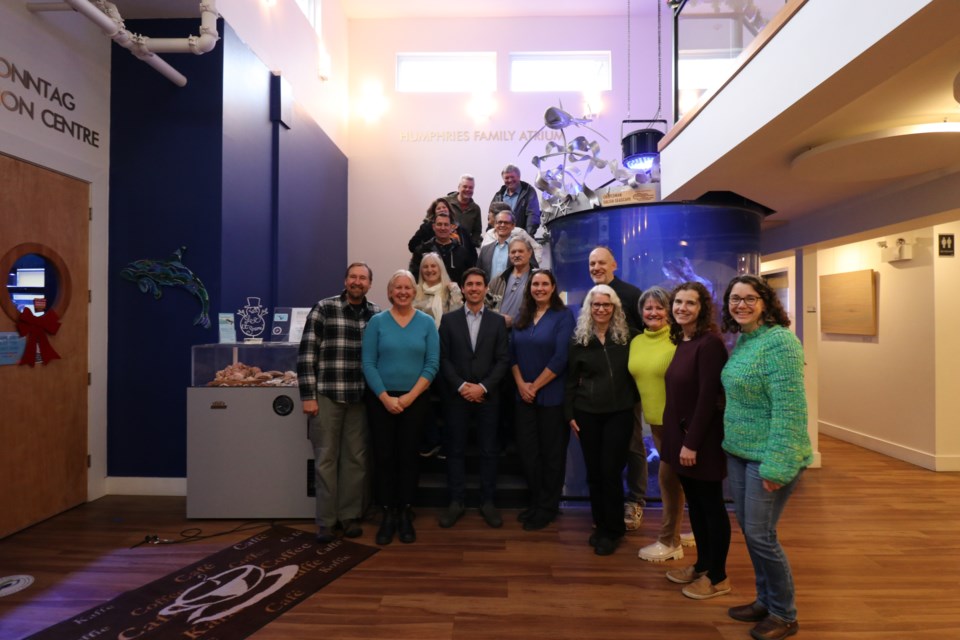If one were looking for an antagonist for the federal funding announcement Dec. 1 at the Nicholas Sonntag Marine Education Centre, it would be warming oceans – and sea urchins.
The federal government is providing more than $12 million in funding from the Aquatic Ecosystems Restoration Fund across six projects dedicated to conserving and restoring aquatic ecosystems.
Just over $1 million of the funding is coming to the Sunshine Coast for a four-year kelp restoration project, led by the British Columbia Conservation Foundation (BCCF) and working with shíshálh and Tla’amin Nations.
Also announced was:
- Nearly $1.7 million over four years for the Tla’amin Nation government for salmon reestablishment work in the Unwin Lake watershed.
- $1.5 million over four years for Comox Valley Project Watershed Society for nearshore restoration along the east coast of Vancouver Island
- $5 million over five years for Nature Trust British Columbia estuarine and riparian habitat restoration in the Salish Sea and North Vancouver Island.
- $Nearly 2.6 million over four years for the Squamish River Watershed Society for salmon habitat restoration in upper Howe Sound, including in the Stawamus and Squamish River estuaries.
- Just over $300,000 over four years for the Skeena Knowledge Trust for a comprehensive salmon-specific project registry.
“Rapidly changing climate is disrupting the ecological balance that much of our aquatic life depends upon and together with historic habitat losses, many of the species that coastal communities rely on are facing dire challenges if left unchecked,” West Vancouver-Sunshine Coast-Sea to Sky Country MP Patrick Weiler said as he made the announcement on behalf of the Minister of Fisheries, Oceans and the Canadian Coast Guard. “These projects will play a key role in restoring aquatic ecosystems right here on the Sunshine Coast and across coastal B.C.”
Local kelp
Back to the sea urchins: after seastar wasting disease started killing off their top predator – the sunflower star – a few years ago, the sea urchin population exploded. Then the sea urchins had free reign to eat the kelp, which have been facing other stressors of warming oceans, and so kelp recruitment has declined in the Sunshine Coast waters.
“Kelp are true ecosystem engineers, they provide three-dimensional structure and habitat for so many fish and invertebrates,” Lee-Ann Ennis, the biologist and technical engineer of the Sunshine Coast-based project, told the crowd. Ennis has worked on kelp cultivation techniques for the past six years, and she said this project is designed to work with Indigenous communities to build capacity to grow kelp locally.
“Our project is going to address the lack of kelp seed recruitment by cultivating local seed for local restoration projects,” she said.
The project will build kelp nurseries, produce local kelp seed and employ Indigenous student interns over three of the next four years (as this year is half over), said Ennis. With approval, and working with marine spatial planners and resource managers, they plan to plant kelp at high-priority sites, starting with a couple of sites, and scaling up to 20 to 25 sites over the next four years.
Ennis noted that work on the project is already under way – Sunshine Coast Community Forest having provided bridge funding from its grants program.
But it’s not just those on the Coast who have been working with kelp, as scientists around the world are working to restore the important species. Ennis works with other studies, working groups, and scientists and brings the information back to the Sunshine Coast to share with Indigenous partners, “so that they are in control of the kelp in their own swiya and their own territories.”



